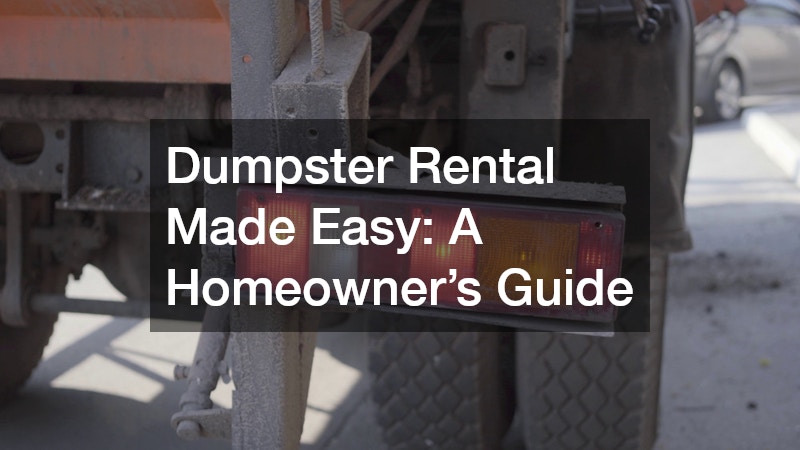
When embarking on a home renovation or major cleanup project, renting a dumpster can greatly streamline waste management. Homeowners often find themselves dealing with more debris than expected, ranging from construction waste to old furniture. This guide aims to assist homeowners in understanding the critical aspects of dumpster rental, ensuring every detail is considered before taking the plunge.
The decision to rent a dumpster involves evaluating several key factors, such as project scale, local regulations, and eco-friendly disposal practices. Homeowners should be aware of the range of dumpster sizes available, as selecting the right fit can prevent unnecessary costs and inefficiencies.
In this guide, we’ll cover everything from choosing the appropriate dumpster size to understanding what items are allowed for disposal.
Understanding Common Dumpster Sizes
Choosing the right dumpster size is critical for ensuring efficiency and cost-effectiveness in any project. Most dumpster rental companies offer sizes ranging from 10-yard for small cleanouts to 40-yard for large-scale demolitions. Homeowners should familiarize themselves with these standard sizes to match their specific needs, avoiding the common pitfall of either overestimating or underestimating the required capacity.
A 10-yard dumpster is ideal for small renovations or minor cleanups, holding approximately three pickup truck loads of waste. For medium-sized projects like home remodeling or larger cleanouts, a 20-yard dumpster is often sufficient, providing space for six pickup truck loads. Larger projects, such as extensive renovations or construction, may necessitate a 40-yard dumpster, which can accommodate around twelve pickup truck loads of debris.
Evaluating Your Project Needs
Before settling on a dumpster size, it’s crucial for homeowners to thoroughly evaluate their project’s scope and waste output. Starting with a detailed project plan, including the types of materials involved and their disposal methods, will provide a clearer picture of dumpster needs. This upfront assessment is not only about quantity but also about the types of waste, as different materials might have different disposal requirements.
Estimating waste volume involves considering all phases of the project, from demolition to cleanup. For example, a kitchen remodel will generate a different type and amount of waste compared to a yard cleanup or attic purge. By taking stock of all areas where waste will be generated, homeowners can ensure they select a dumpster that is sized to fit.
Consulting with Rental Companies
Seeking professional advice from rental companies can be invaluable in selecting the correct dumpster size and service appropriate for your project. Rental companies possess in-depth knowledge regarding local regulations and can advise on permitted items, placement, and size selection. Initiating a conversation with a rental service member will offer direct insight into the rental process and help refine your project estimates.
Speaking with representatives from multiple companies will provide varying perspectives on pricing and service. While doing so, it is wise to ask questions about any additional fees, weight limits, rental durations, and terms of use. Companies should willingly guide you through their policy structures to foster informed decision-making regarding dumpster rentals.
Identifying Hazardous Materials
Not all materials are safe to dispose of in a dumpster, and many carry environmental and safety risks. Hazardous materials, such as paints, chemicals, or asbestos, require special disposal methods and should not be thrown into regular dumpsters. Proper disposal of these substances ensures the safety of landfill workers and environmental protection.
Disposing of hazardous waste improperly can result in significant fines and legal consequences for homeowners. Identifying these items before starting the project allows you to make alternate arrangements for their disposal. Common household items like batteries, tires, and certain appliances also fall under this category, necessitating specialized handling.
Budgeting for Your Dumpster Rental
Budgeting for dumpster rental involves planning meticulously to accommodate potential fluctuations in cost. Homeowners must balance project needs against financial limits, considering dumpster sizes and load capacities as part of a broader project budget. Setting aside a contingency fund for unexpected expenses can prevent project stalls from unforeseen cost increases.
To create a realistic budget, homeowners should obtain and compare quotes from several vendors. Rental companies may offer package deals or discounts for extended rentals, so it’s worth discussing long-term requirements. Keeping an open line of communication with the service provider ensures expeditious resolution of issues as they arise.
Comparing Rental Companies
Finding the right dumpster rental company entails evaluating multiple factors, such as reputation, pricing, and customer service. Reading online reviews, soliciting recommendations, and directly engaging with company representatives are valuable strategies to assess reliability and service quality. Comparing services across several companies ensures competitive pricing and response agility.
In summary, renting a dumpster can simplify home renovation and cleanup projects when approached thoughtfully. By carefully considering project requirements, consulting with rental companies, and adhering to local regulations, homeowners can achieve a seamless waste disposal experience. Embracing sustainable disposal practices complements this process, ensuring environmental and project integrity.
This guide offers a comprehensive framework for understanding the intricacies of dumpster rental. Proper planning and informed choices enable homeowners to navigate potential challenges efficiently. The benefits of following this structured approach are reflected in terms of cost savings, regulatory compliance, and overall project satisfaction.
Ultimately, effective dumpster rental practices promote responsible waste management, streamlined project execution, and enhanced homeowner experience. By integrating the insights and strategies detailed here, homeowners can confidently tackle their undertakings, transforming aspirations into accomplishments with reduced stress and increased efficacy.



